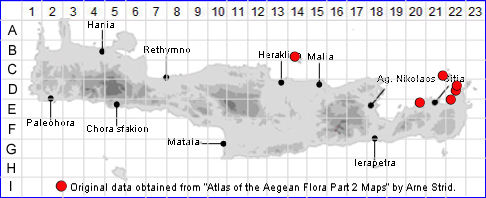
SPECIES DESCRIPTION
CARLINA DIAE
Family:- COMPOSITAE/Subgen. LYROLEPIS
Common Name:- None
Synonyms:- Lyrolepsis diae
Meaning:- Carlina (L) For Charlemagne (742-814) Emperor of Rome (whose army
was supposed to have been cured of the plague with a species of Carlina, which the
Archangel had revealed to him).
Diae (L) From the island of Dia, Crete.
General description:- Rigid perennial, strongly woody below. Plant densely
covered in short white-grey soft, matted hairs throughout
Stems:-
1) Flowering, 15-70 cm, erect, simple or sparingly branched above, sparsely leafy.
Leaves:-
1) Basal, oblanceolate, obtuse to acute, entire or rarely with a few teeth, densely
white- or grey tomentose.
2) Cauline, similar, but smaller Mostly crowded on short non-flowering branches.
Flowers:-
1) Involucre, broadly obconical.
2) Outer involucral bracts, 10-15 x 3-5 mm, entire or pinnatifid.
3) Inner involucral bracts 10-16 mm.
2) Outer phyllaries somewhat shorter, resembling ligules, pale yellow with brownish
or purplish tinge.
3) Florets, dull yellow.
4) Capitula 15-20 mm in diam, in small corymbs of 2-4.
Fruit:-
1) Achenes c. 5 mm sericeous.
2) Pappus, sericeous, shorter than the achene.
Key features:-
1) Plant rigid, entirely without spines.
Habitat:- Crevices of hard limestone cliffs, usually near the coast 0-150(-400) m.
Distribution:- Endemic to Crete.
.
Flowering time:- June-Aug.
Photos by:- Photos by Kind permission of Manolis Avramakis, Natural History
Museum of Crete.
Status:-
Conservation status (for threatened species): Vulnerable (V) according
to the Red Data Book of Rare and Threatened Plants of Greece (1995).
IUCN 1997 Record it as Vulnerable (V).
Protection status (for threatened species): Greek Presidential Decree 67/1981,
Bern Convention, EU Dir.1992/43 (Ann.IV)
